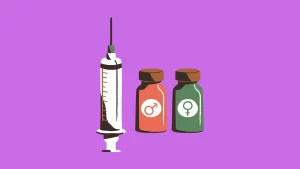Introduction
Changing chemical levels are primarily responsible for the maturing process that occurs within the female regeneration framework. When your periods end completely for good, it’s a blatant sign that you’ve reached an adulthood stage. This transitional period is referred to as menopause. Menopause is a natural part of a woman’s maturing process and should not be surprised by its occurrence. What menopause symptoms? Go through for more details.
What is Menopause?
The menopause is the time in a woman’s life when she stops having periods as a result of a change in the levels of certain chemicals in her body. This is something that could happen in a natural setting. Or as a result of factors such as a hereditary explanation, a medical procedure to remove the ovaries (oophorectomy) or the uterus (hysterectomy), chemotherapy or other treatments for malignant growth, or a combination of these. There are occasions when the explanation is not quite clear.
The period of time during which a woman experiences symptoms before to the complete cessation of menstruation is referred to as the perimenopause. When a woman has not experienced menstruation for a significant amount of time in a row, she is considered to have entered the menopause.
It is really important to have a solid understanding of the menopause symptoms. Acquaint yourself with the symptoms that can accompany the menopause. The perimenopause is the time leading up to menopause, and it can bring uncomfortable symptoms such as irritability, mood swings, a foggy head, hot flashes, and irregular periods. These symptoms can start to manifest themselves a considerable amount of time before your periods stop, and they may continue after menopause has taken place.

Overview
The change in a woman’s reproductive system known as menopause often takes place between the ages of 45 and 55 and is marked by the complete cessation of menstrual cycles. After a year has passed in which you have not experienced a period of menstruation, it is then examined. In spite of this, the word “menopause” is frequently used to refer to the full period of time during which a woman will be experiencing the symptoms associated with menopause. This may continue for a considerable length of time after the bleeding has stopped, and it may continue for a considerable length of time after the bleeding has stopped.
The menopause is a natural cycle that women go through at a specific point. However, the actual side effects of menopause, such as hot flashes, and the more profound side effects of menopause may cause sleep disruption, a decrease in energy, or an influence on the wellbeing of those in your immediate environment. There is a wide variety of effective treatment options available today, ranging from adjustments to one’s way of life to pharmaceutical intervention.
The Roles of Chemicals'(hormones) in Menopause
Progesterone and Estrogen
The hormones estrogen and progesterone have a vital role in the development of the endometrium, which is the lining of the uterus and is arranged in a manner that is consistent with a potential pregnancy. In the event that the egg is not processed, the production of chemicals will decrease. The term “monthly cycle” refers to the process in which the endometrium sheds for a period of time that is more than a couple of days and occurs when progesterone levels fall below a certain threshold.
As the levels of estrogen and progesterone drop, the production of FSH is restarted, and the cycle starts all over again. As women get older, the number of eggs that they have in their ovaries begins to decrease, there is a reduction in the number of follicles that are accessible, and chemical levels begin to change. When this phenomenon first starts to take place, it is almost always an indication that menopause is just around the corner.
Estrogen
Estrogen is the superior molecule for female sexual performance. It is produced in the ovarian tissue from a variety of precursor chemicals and plays several roles. These roles are assisting your body through the critical cycles of ovulation, fertilization, and the beginning of a pregnancy, and also assisting with maintaining bone thickness and managing cholesterol.
Once a woman has reached menopause, the amount of estrogen that is produced by her ovaries drops to approximately 33 percent of what it was previously. The precursor chemicals produced by the ovaries continue to make their way through the circulatory system until they reach the fat cells, where they are converted into oestrogens. Because of this, it makes perfect sense that after menopause, women who are overweight and have a large number of fat cells will have far higher levels of estrogen in their circulation than women who are not overweight.
This decline in estrogen production has been linked to osteoporosis as well as a variety of other health problems, all of which may be helped by the administration of estrogen replacement therapy.

Progesterone
Together with estrogen, progesterone helps to direct the female reproductive cycle and prepares the body for conception and pregnancy. Progesterone’s role in this process is complementary to estrogen’s. Estrogen and progesterone work together to prepare the uterus for the arrival of the developing organism: estrogen induces multiplication of the endometrium (also known as “fabricating the house”), and progesterone turns the increased endometrium into a secretory stage (also known as “placing the furniture in”).The levels of progesterone in the body begin to fall once women begin to experience the symptoms of menopause. Your periods may become unexpected as a result of a drop in the hormone progesterone during the perimenopause. This is one of the reasons why your periods may become unpredictable during the years in which you were trying to have a child. Progesterone was a component of the hormonal control of the typical monthly cycle throughout those years.If you opt for chemical treatment during menopause and your uterus is still healthy, your primary care physician will most likely recommend a medicine that contains both estrogen and progesterone. This is due to the fact that estrogen-only treatment will increase your risk of developing endometrial malignant development.
Androgen
Androgens, which are restricted amounts of testosterone, are produced not only by males but also by women, and these are furthermore delivered in antecedent structure in the adrenal organs and the ovaries. The spray of development that young women go through in the early stages of pubescence is partially attributable to the presence of these substances.
As you go through menopause, your body’s production of the hormone androgen drops by almost half. Androgens, when used as part of a chemical treatment, can lead you to feel more excited, increase your charisma, and help with the alleviation of hot flushes; however, androgens also have significant negative effects, and the specialist will only recommend them if a certain symptom is present.
Common Menopause Symptoms
The time leading up to menopause is referred to as the perimenopausal period, and it can last anywhere from a few months to several years. During this time, you may experience the following symptoms and side effects:
- Hot flashes and night sweats
- Irregular periods
- Vaginal dryness
- Loss of Libido
- Sleep disturbances.
other symptoms of menopause
- Weight gain
- Memory changes and brain fog
- Joint aches and pains
- Hair thinning and skin dryness
- Bladder control problems.
Managing Menopause Symptoms
Lifestyle Changes
Many of the symptoms and side effects associated with menopause are only temporary in nature. This is especially true of the symptoms. The following steps can be performed to assist prevent or decrease the effects of their belongings:
- Make working out a regular part of your regimen. If you want to reduce your risk of developing cardiovascular disease, diabetes, osteoporosis, and other conditions that are associated with aging, you should try to get regular exercise or job that uses your muscles.
- Maintain a healthy eating schedule for yourself. Incorporate a wide variety of organic products, vegetables, and grains in their whole form. Reduce the amount of fats, oils, and sugars that are consumed when immersed. Inquire as to whether or not you truly require calcium or vitamin D enhancements in order to assist with meeting the requirements of everyday life.
- Do your best to stop the habit of smoking. If you smoke, you increase your risk of developing cardiovascular disease, stroke, osteoporosis, and a wide variety of other diseases and health problems. It is also possible that it will increase hot flashes and a sense of well-being in women who are approaching menopause.
- Get some practice with the various methods of unwinding. It is possible that techniques such as deep breathing, timed breathing, guided visualization, back rubs, and modest muscular relaxing may be helpful in reducing the negative effects of menopause. You can find a variety of books and articles online that contribute to the topic of showing various de-stressing exercises.
- Work on strengthening the muscles that support your pelvic floor. Exercises that focus on the pelvic floor muscles, often known as Kegel exercises, could be helpful for addressing specific types of urine incontinence.
- Cool hot glimmers. Put on layers of clothing, drink plenty of water, or find a spot that is significantly cooler than where you are right now. Make an effort to identify the spark that starts your fires burning so furiously. Some women are more susceptible to hot flashes than others, and the factors that can bring on an episode include things like hot drinks, coffee, spicy foods, alcohol, stress, hot weather, and even a hot room.
- Decline vaginal discomfort. Try a vaginal ointment that is available without a prescription and is formulated with water (such as Astroglide, K-Y jam, or Sliquid), or a silicone-based grease or lotion (such as Replens, K-Y Liquibeads, or Sliquid). Both of these products can be purchased over the counter. In the event that you are sensitive to the component in question, you ought to give careful consideration to purchasing a product that does not include glycerin, since this component, if consumed in large quantities, can lead to drowsiness or other uncomfortable side effects. Keeping physically active helps alleviate vaginal discomfort because it increases blood flow to the vagina, which in turn relaxes the vaginal muscles.
- Get sufficient rest. Stay away from coffee, as it may make it difficult for you to get to sleep, and try not to consume too much alcohol, as it may prevent you from falling or staying asleep. Maintain your routine throughout the day, and not only in the hours leading up to bedtime. It’s possible that you won’t be able to get a suitable amount of sleep unless you figure out how to deal with hot glimmers, in the event that they disrupt your sleep.
Natural Remedies and Alternative Therapies
Some women with vaginal microbial syphilis prefer to manage their condition with various seasonings and dietary modifications as opposed to using chemical replacement therapy. There are several different options available for the treatment of menopausal symptoms that are considered to be standard.
Dark Cohosh
Symptoms: Hot flashes, chills throughout the night
The extract known as dark cohosh comes from a specific variety of buttercup. The effectiveness of dark cohosh in reducing the appearance of hot flashes has been the subject of a number of studies, which have produced conflicting findings. A couple of studies suggest that it might be helpful in the short-term treatment of mild hot flashes and night sweats. It’s possible that this will slow down your pulse as well. Hepatitis has been identified as a possible cause in a few isolated incidents.
Soy
Symptoms: Hot flashes, chills throughout the night
Isoflavones, which are a type of phytoestrogen (also known as a plant estrogen), can be found in soy. A few studies have shown that soy may be effective in reducing the negative effects that come along with menopause. Despite this, a variety of investigations have not discovered any advantages. The only sorts of soy products that are recommended are food ones, such as tofu and soy milk. The consumption of soy in the form of tablets or powder is not recommended.
Flaxseed, either crushed up or extracted into oil:
Symptoms: Hot flashes
In addition to containing omega-3 unsaturated fats, flaxseed also contains lignans, which function in a manner similar to that of phytoestrogens. The findings of several studies have been contradictory, however some women who take it may experience less adverse effects from it. In addition, the fact that it helps decrease cholesterol is widely acknowledged. Steer clear of whole flaxseeds because they are difficult to process. Whole flaxseeds should be avoided.
Vitamin E
Symptoms: Vaginal Dryness, Hot Flashes
When effective vitamin E oil is applied to the vagina, it not only encourages the production of grease but also has the potential to reduce hot flashes.
Chemicals'(hormone) Replacement Therapy
During menopause, your estrogen levels fall. Some women experience embarrassing side symptoms known as vasomotor side effects, such as hot flashes. Other women may experience distinct adverse effects, such as vaginal dryness. The most effective treatment for the symptoms that come along with menopause is hormone replacement therapy, sometimes known as HRT. Other names for this treatment include chemical treatment, menopausal chemical treatment, and estrogen substitution treatment. For example, Estrogen tablet, Estrogen fix, Vaginal estrogen and Effective estrogen.
Conclusion
The menopause is a natural cycle that women go through, and it is important to have a good awareness of the symptoms associated with it. Managing these negative effects can also contribute to an increased sense of personal happiness.


